Note You are currently viewing a previous version of this narrative statement as published in previous iterations of the KEF (KEF1 and KEF2). View the latest version
Institutional Context
Summary
The University of Wolverhampton (UoW) is an anchor institution whose priorities are influenced and shaped by our place and informed by local knowledge and partnership engagement.
We have a significant regional footprint operating from a number of strategic centres in key locations. This operating model enables us to make a significant contribution to improving the educational, social and economic outcomes for our students in a region that has suffered disproportionately from industrial restructuring.
Creating and delivering opportunity for our students and our place utilising knowledge exchange whilst delivering impact is how we make a lasting difference. Through partnership working and collaboration we transform individual life chances for the benefit of our students and our place.
Institutional context
Since its inception as a Mechanics Institute in 1827, the University of Wolverhampton has been committed to putting our students first and addressing the challenges of our place.
Our approach is driven and inspired by our vision ‘to transform the leadership and workforce of our place through inclusive student success and world-class research’ and delivered in partnership with our stakeholders and partners from across our communities. Our priorities are influenced and driven by our location and have an explicit focus on skills, employment and applied research.
Our submission outlines and demonstrates an operating approach that is grounded in partnership working and predicated on delivering impact. Our whole institution approach directs us and our model of reciprocity informs us. The impact of this is evident in many examples, be it the Wolverhampton City Learning Region, our community approach to STEM (science, technology, engineering, and maths) or how we have worked with our communities in Telford to tailor and offer that is directly responsive to their needs. The results and learning outcomes speak for themselves.
Place, partnership, and people matter to us and throughout our submission there are many examples that demonstrate our passion and commitment to provide opportunities for our communities and our students to progress in their lives and into well-paid, rewarding careers.
Across our faculties and professional service areas we work closely with the private sector and a range of industry partners to ensure that, as a collective, we understand the needs of our place and from there develop sustainable plans and solutions. It is through these links that we maximise opportunities for our students and graduates. Our offer and intervention are targeted and predicated on addressing need, creating opportunity, and delivering sustainable impact. Good examples of this are our Springfield Campus development and the Marches Centre for Cyber Security. We have worked hand-in-glove with our business community to create these centres of excellence which are industry informed and predicated on knowledge transfer and knowledge exchange principles and practices. The results shown in the Local Growth and Regeneration chapter demonstrate our solid progress.
However we know that we must remain flexible and agile in our approach. The ongoing impact of the Covid-19 pandemic shows why institutions like ours that are firmly rooted in place matter so much. Throughout the pandemic we were able to build on existing relationships and agreements with our civic partners. These established structures meant that we could easily engage and work directly with local businesses. This enabled us to offer expertise and equipment to partners in all sectors, particularly where a business or organisation had identified an opportunity for a new product or service that could help the crisis response.
Our submission shows that we are making a real difference to our business base, our people, and our place. Our achievements have been built through partnership working, trust-based collaboration, and engagement and a commitment to the wellbeing and success of our place. It demonstrates our role and value as the University of Opportunity.
For further information, please send queries to nazira.karodia@wlv.ac.uk
Local Growth and Regeneration
Summary of approach
University of Wolverhampton (UoW) is committed to its civic role and duty. As an anchor institution operating across the West Midlands, transforming its society by ensuring the needs of place and people are at the heart of everything. Place informs the courses taught, research delivered, skills it equips people with and regeneration projects invested in. Our approach to local growth and regeneration focuses on skills, improvements to physical place and economic development.
UoW leads on several ambitious local growth and physical regeneration projects to drive economic growth through delivery of skills and knowledge exchange programmes within a clearly defined geography. With Inclusive Student Success and Place at its core, our 2030 strategy cements our position as the University of Opportunity.
Aspect 1: Strategy
UoW’s expansive footprint presents major opportunity to define and shape the skills, economy and physical place in the areas we operate.
The map below illustrates our physical footprint which we consider to be our local area.

(*We have campuses / physical assets at all locations featured on the map, not just the locations where the four specific projects have been highlighted*
https://www.wlv.ac.uk/about-us/contacts-and-maps/all-maps-and-directions/ )
UoW resides within West Midlands Combined Authority (WMCA) which includes 18 local authorities and three local enterprise partnerships (LEPs). We are proud of our regional footprint and our work is shaped and informed by our external stakeholders and partners from across the communities within which we operate.
UoW is a lead deliverer of the ‘People, Skills and Employment’ strand of the West Midlands Local Industrial Strategy (WMLIS) and the regional skills plan within it. The strategy builds on the strengths of the automotive, life sciences, creative and business services sectors with digital and construction as cornerstones at the heart of the regional economy to deliver inclusive growth and high-skilled jobs.
We operate on an evidence-based approach to address the skills, social, economic and cultural needs of the places we serve and to achieve our local growth and regeneration outputs within our defined geographical areas. Our Strategic Plan 2016-2021, Vision 2030, Research, Regional (includes Community) and Business Engagement sub strategies explicitly list and deliberately align with thematic priorities and key employment sectors set out in the WMLIS (diagram 1)) and complements the strategic economic plans of the three LEP areas within which we operate – Black Country LEP, Marches LEP, Stoke and Staffordshire LEP.

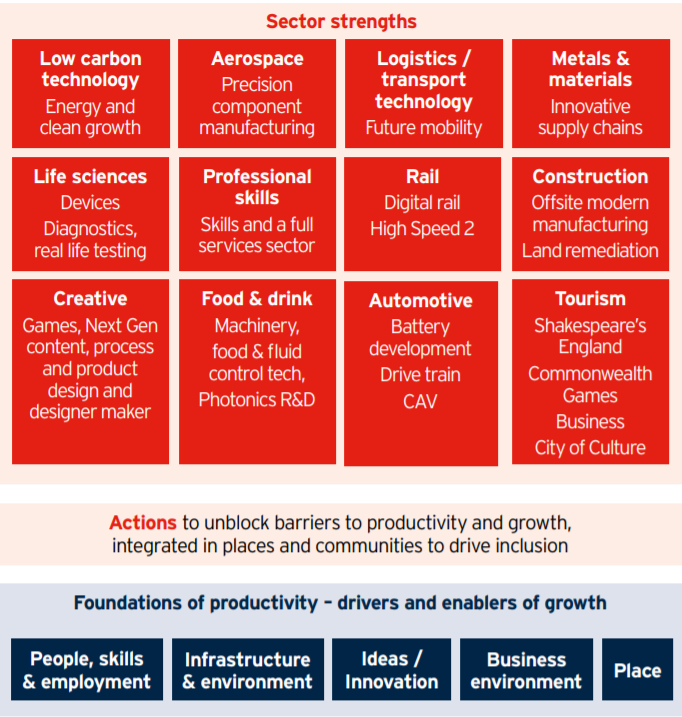
Diagram 1: 5 Foundations of Productivity – West Midlands Local Industrial Strategy and Sector Strengths
To understand regional strategic priorities, evidence need and ensure that our skills, place improvements and economic development activities are aligned to the skills and economic priorities of each LEP area, we have developed exceptional working relationships with the three LEPs (board and steering group members of two); civic and business support organisations, including City of Wolverhampton (CWC), Walsall, Telford & Wrekin (T&WC), Hereford & Worcester (H&WC), Staffordshire County (SCC) and Shropshire councils; chambers of commerce, growth hubs and public and private sector organisations. Undertaking formal consultation with our delivery partners ensures we continually deliver against the regional priorities (diagram 1) to improve place and the regional economy.
Several regeneration projects, including the £100m Wolverhampton Springfield Campus, £9m Midlands Centre for Cyber Security in Hereford and £5m Marches Centre for Excellence in Allied Health and Social Care in Telford, feature robust partnership working between UoW, LEPs, local councils and wider partner stakeholder groups from both public and private sector. These named partners on a number of regeneration projects are undertaking a specific, critical role. These projects are aligned to the thematic priorities of Department for Business, Energy & Industrial Strategy (BEIS), European Regional Development Fund (ERDF), WMLIS and LEP Strategic Economic Plans which include:
BEIS – Industrial Strategy – 5 Foundations
ERDF Priorities for 2014 – 2020
Several of our successful local growth and regeneration programmes rely on external funding mechanisms administered through LEPs such as ERDF, Growth Deal, Land and Property Investment Fund. Funds are awarded based on the ability to evidence ‘need’ against the strategic priorities of each LEP via a full business case and application. Since 2016 the University has managed 20 public funded projects with a total project value of £61m and a total grant value of £31m delivering across three LEP areas.
Aspect 2: Activity
The following activities are key outputs of our Strategic Plan 2016-2021 and 2030 Vision Strategy, each project contributes to the ‘People, Skills and Employment,’ ‘Place,’ and ‘Business Environment’ thematic priorities of WMLIS ‘foundations of productivity’ outlined in the ‘strategy’ section.
Springfield Campus

The £100m Springfield Campus seeks to stimulate economic regeneration in Wolverhampton and the BC by creating a national centre for sustainable construction and circular economy on the 12 acre site, bringing together school level education, employer training provision and higher education on one site.
The campus is a significantly important regeneration project for the WM and when fully operational will be the world’s largest construction education campus developing the skills and knowledge base for the future of construction.
In August 2020, UoWs School of Architecture and Built Environment (SOABE) re-located to a purpose-built £28m building on the campus, delivering the glue which will hold the public sector offer together, unlocking private sector industry partners, professional bodies, and supply chain members to ‘buy in’ to the vision for the campus and commit to co-location and/or co-delivery of education, research and innovation.
The vision for Springfield Campus responds to three of the BCLEP’s five transformational growth sectors – advanced manufacturing, building technologies, and environmental technologies.
UoW worked closely with the WMCA, BCLEP, CWC to understand their strategic growth objectives outlined in BCLEP strategic economic plan, our application to growth deal funding evidenced how SOABE will unlock these objectives by:
raising employability, education and skills
improving BC business competitiveness

School of Architecture and Built Environment at Springfield Campus
Brownfield Research and Innovation Centre (BRIC)
BRIC actively supports the remediation of brownfield land and buildings, bringing them back into use and offering opportunities to improve the BC’s economic performance by increasing provision of quality development sites. Ongoing needs analysis and partner consultation ensured BRIC is fully supported by the BC Consortium, and the four BC local authorities.
BRIC highlighted urgent need for high quality brownfield research and innovation across the WM and provided the catalyst for the establishment of a National Brownfield Institute (NBI), led by UoW, in partnership and supported by key stakeholders, including CWC, BCLEP and WMCA, to create a world-class industry cluster focusing on brownfield regeneration at Springfield Campus.

Artist’s impression of National Brownfield Institute
Elite Centre for Manufacturing Skills

The £12m Elite Centre for Manufacturing Skills (ECMS) based at Springfield Campus opened in August 2017, and was identified a flagship project in the BCLEPs 2014 SEP, which committed £8.2m Growth Deal funding.
An exemplar, employer-led training facility for the BC designed to improve productivity and growth in the high value manufacturing sector, one of the five transformational sectors for the BC, with particular emphasis on the aerospace and motor vehicle sectors, the centre provides training in:
toolmaking
foundry
metal-forming
metal treatment
advanced CNC
manufacturing/ project management & leadership
These skills underpin high value manufacturing performance, productivity and growth. ECMS was created through Skills Capital investment by government and through consultation with the BCLEP.
Midlands Centre for Cyber Security

Artist’s impression of Midlands Centre for Cyber Security
The Marches SEP identified a lack of critical mass of business activity, a limited university offer, low levels of R&D and commercialisation and poor virtual connectivity. In response, UoW has invested £500,000 through its Research Investment Fund to set up Wolverhampton Cyber Research Institute (WCRI).The focus is to enhance cybersecurity research and KE, develop and sustain a leading, world class, multi-disciplinary cyber research centre to influence cyber policy and decision-making, ensuring protection of businesses and individuals in cyberspace.
WCRI plays a leading role in the Cyber Quarter - Midlands Centre for Cyber Security at Hereford. Cyber Quarter’s mission is to be a single hub for supporting and accelerating cybersecurity innovation and supporting industry by providing tailored security testing, training and R&D services. It supports the incubation and acceleration of cyber businesses and helps new innovative cyber products and services to be developed and tested.
ERDF Business Growth Projects
UoW administers several ERDF business growth programmes focusing on addressing strategic and operational challenges faced by BC, Marches and Stoke and Staffordshire LEPs priority sectors and companies operating within them. Programmes effectively support SMEs with growth plans, innovation or give them a competitive edge and are aligned to specific needs via in-depth consultation. Programmes contribute to strategic investment, ERDF Priorities for 2014 – 2020 and the strategic economic plan priorities of the LEP area in scope.
Projects contribute to the ‘Business Environment’ and ‘Ideas/ Innovation’ thematic priorities of WMLIS ‘foundations of productivity’:
Built Environment Climate Change Innovations (BECCI) engages with SMEs, linking them to our academic experts to drive product and service innovation that will contribute to the UK campaign to reduce C02 emissions. The BECCI team provides practical support so help SMEs engage with these innovations in the areas of insulation, building fabric, ventilation, heating and cooling controls, battery storage and smart grid.
The Composite and Additive Layer Materials Engineering Research and Innovation Centre (CALMERIC) provides advanced engineering and manufacturing companies with the opportunity to develop high performance components that are lightweight and make efficient use of materials. The innovations developed by CALMERIC are particularly relevant to businesses operating within aerospace, automotive, motorsport and wind energy supply chains.
Environmental Technologies & Resource Efficiency Support Service (ENTRESS) provides bespoke 1-1 support to SMEs in the adoption of technologies and processes for reuse, recycling and recovery of materials and resources and supporting SMEs developing novel technologies and processes for reuse, recycling and recovery of materials and resources. This supports the ambition of the BCLEP for the region to become a low carbon economy.
ENTRESS successfully supports many strands identified in the Black Country EU Structural and Investment Strategy.
Smart Concept Fund is a proof-of-concept fund designed to support the commercialisation of new technologies developed by businesses and universities. It specifically targets technologies that are consistent with SMART Specialisations and local priorities in the BCLEP, Stoke/Staffs and Marches LEP areas.
https://www.youtube.com/watch?time_continue=95&v=IG10pq78ro0&feature=emb_logo
Science in industry research centre (SIRC) based at UoW Science Park brings together science researchers with local SMEs – entering into research collaborations and developing the University’s research focus towards commercial applications.
Digital Enterprise (SOLVD) identifies digital needs and provides technology solutions. It increases business engagement within the Marches LEP by setting-up industry challenges that local micro and other SMEs can help solving in vast areas of joined industry and commercial collaborations.
UoW delivered the ERDF part-funded IPSS (Innovative Product Support Service) project (2013 – 2019), managing the partner participation of Keele University, Birmingham City University, Staffordshire University, Aston University and Coventry University in delivering innovation support activities from the Universities to SME companies in the West Midlands. Partners delivered knowledge exchange to over 400 companies to progress their new product development projects through IPSS.
Aspect 3: Results
The outcomes and impact achieved as a direct result of our strategic planning activities illustrate how UoW delivers education, skills, applied research and KE to meet local needs focusing on the strategic priorities of our key partners.
The physical regeneration and ERDF business growth projects outlined below are key outputs of the ‘People, Skills and Employment,’ ‘Place,’ and ‘Business Environment’ strands of the WMLIS.
Springfield Campus
Over a 30-year business case lifetime, the delivery and operation of Springfield Campus will support 6,432 net additional Full Time Equivalent (FTE) jobs within the Black Country, with such employment gains bringing an additional £590m GVA over the period
Springfield Campus and SOABE are already delivering these outputs.

The ECMS brought together partners from high value manufacturing and education sectors including UoW, Dudley College, In-comm training, Confederation of British Metalforming, Cast Metals Federation and Institute of Cast Metals Engineers to set up a hub and spoke model which includes the National Foundry Training Centre. The centre based in Tipton is the only foundry training centre in the UK where foundry apprenticeships and foundry specific short courses are delivered.
The ECMS Springfield Hub, delivers short course training, leadership/management development and metallurgy training for manufacturing and engineering sector.
Springfield Campus Economic Impact Assessment, November 2015, updated February 2018)

https://www.blackcountrylep.co.uk/upskilling-growth/elite-centre-for-manufacturing-skills/
https://www.blackcountrylep.co.uk/upload/files/Case%20Studies/ECMS.pdf
Midlands Centre for Cyber Security (MCCS)
MCSS will make a significant contribution in stimulating innovation growth in sectors that rely on defence/security and other cyber-security interests. The Marches LEP prioritised the Centre within its key projects for its third Growth Deal focusing on projects that assist in raising skills, business productivity and increasing business engagement in research and innovation.
Our Wolverhampton Cyber Research Institute within the MCSS opened in late 2020 and has already secured research grants and is engaging in SME business assists.

https://www.insidermedia.com/news/midlands/work-reaches-milestone-on-9m-cyber-security-centre
ERDF
Significant impact and outputs were achieved across our ERDF projects in the defined period, contributing to the ‘Business Environment’, and ‘Ideas/ Innovation’ strand of the WMLIS. All ERDF projects are evaluated in a third party summative assessment, and our contribution to the regional economy is acclaimed.

Example case studies providing evidence of beneficiaries who have accessed our expertise and support via each funded project illustrating impact and how UoW seeks to address the challenges faced by business operating in the region:
BECCI Case Studies
https://www.wlv.ac.uk/business-services/funding-and-support/becci-project/case-studies/ecolec/
https://www.wlv.ac.uk/business-services/funding-and-support/becci-project/case-studies/ecostruct/
https://www.wlv.ac.uk/business-services/funding-and-support/becci-project/case-studies/jr-property/
BRIC Case Studies
ENTRESS Case Studies
https://www.wlv.ac.uk/business-services/funding-and-support/entress/case-studies/
Smart Concept Fund Case Studies
IPSS Case Studies
https://www.insidermedia.com/blogs/midlands/ipss-innovative-product-support-service
For further information, please send queries to r.nicklin@wlv.ac.uk
Public & Community Engagement
Summary of approach
For the University of Wolverhampton, public and community engagement is about people in their place. We use our expertise, resources, and commitment to make lasting differences to the lives of people of all ages. We work collaboratively with our partners and communities to achieve mutual benefit. We use our knowledge, passion and enthusiasm for learning to light people’s imagination, transform their thinking, stimulate innovation, and open opportunities and employment. We invest in buildings, highly-skilled people, and initiatives to make this happen. Our strategic approach is embedded in our DNA and focuses on reducing the challenges our communities face. We are making a difference, creating new opportunities and are proud of the impact our knowledge exchange approach is achieving.
Aspect 1: Strategy
As the ‘University of Opportunity’ our place informs our strategic approach. We believe that ‘universities are about transforming society by ensuring the needs of their place and people are at the heart of what they do’ (Vision 2030) and our public and community engagement (P&CE) addresses ‘people in their place’. Unlike other universities where P&CE is a separate strand, the social and economic challenges of our place necessitates an embedded, whole-institution approach. Place shapes the University’s future and we help to shape it. Commitment to opportunity is guided by values of equity, inclusion and diversity, shapes our collaboration and partnership approach and ensures that P&CE is strategically embedded focusing on addressing the specific, prioritised needs which are agreed with our partners/communities (and which have been further exacerbated by COVID-19) to achieve long-term sustainable impact.
Our resources, support, and activities are targeted and predicated on creating/enhancing opportunity by removing barriers to prosperity for communities. Given the complexity of the challenges in West Midlands and Black Country towns/cities and the size of our footprint, we are clear about the contribution we make as an anchor institution in bringing employment/skills/learning/funding and innovation and we work reciprocally with our public/communities (Diagram 1).

Diagram 1: Our Public and Communities
P&CE is one of the University’s greatest strengths and is embedded in its culture and owned by all staff. The Community Engagement Statement provides the framework for core strands of external-facing activity. This is informed by intelligence, sub-strategies, and investments demonstrating commitment. Engagement is not a series of separate activities, but a place-based model focused on addressing challenges and improving aspiration, ambition, and opportunity. Reporting is through senior governance committees, led by the VC and PVC (Regional Engagement).
Using four complex integrated place-based challenges, we will demonstrate our strategic approach. These show how, though P&CE, KE occurs with/in our communities to achieve mutual benefit and gradual change.
Changing the community’s view of STEM: In partnership with key stakeholders, our P&CE in STEM has sought to be transformational addressing low participation rates, limited access to sciences and outdated/limited understanding of what STEM entails - resulting in low take-up, attainment, progression and interest/understanding of value and opportunities for employment, innovation and investment.
Helping Telford grow and prosper: Persistent low aspirations and skills deficits have hampered Telford’s growth. A sustained P&CE programme has put learning at the heart of Telford and increased understanding of its value, the range of opportunities, and enthusiasm for what it offers.
Building a learning city: With key strategic/learning partners we are creating the Wolverhampton City Learning Region (WCLR)1 which seeks to put learning at the heart of economic and social development as part of UNESCO learning cities network to address low aspirations, qualifications, and skills levels.
Arts, culture, and inclusion: Using arts/cultural activities we work collaboratively with diverse groups and communities to address hidden issues and break-down barriers.
Aspect 2: Support
To create transformation, our P&CE must light the imagination, engender innovation, and/or open new learning, employment, innovation opportunities. It covers the life-course capturing the excitement of knowledge of children and families through Children’s University, to schools2/colleges, businesses/3rd sector to U3A. Much activity is hidden and unquantifiable. To achieve effective KE, our investment support is three-way: infrastructure, people, and initiatives. This sows seeds of what is possible, exciting, and relevant for people.
Investment in STEM in the last 3-5 years demonstrates this approach. Support for people in the last three years includes the STEM outreach team, staff with new STEM expertise, and the creation of a fellow of STEM public engagement. Infrastructure includes a new science centre including outreach lab, state-of-the-art engineering facilities, science/prototyping centre, cybersecurity centre and upgrading of spaces. Initiatives include the Formula 3 Racing car infrastructure, annual SciFest and ArtsFest, Discover Digital festival, and P&CE across our region. After investment of c£17.9m in 13/14-14/15, we have spent by over £14.1m in new STEM initiatives in 16/17-18/19 (excluding new staffing).

Formula 3 Racing Car

Discover Digital Festival, Telford

Discover Digital STEM Event with NASA astronaut at University Centre Telford

STEM at Gatehouse Theatre
As 80% of students and 86% of staff live within 25 miles of the University’s main campus, our commitment to place and people is embedded. We recruit to dedicated P&CE roles, e.g. engagement officers and others include elements of P&CE. Given our diversity, we commit resources to training and development for staff and students to ensure inclusivity and we provide specialist P&CE-related CPD for staff and partners.
Student opportunities mirror this commitment to place, through partnerships with businesses and third sector organisations. Since 2016, we have coordinated 11,628 volunteering/internships/placement opportunities, including 1,401 businesses engaged with volunteers. Similarly, our programme of support for students has resulted in employment of GTAs/academic coaches/student transition teachers of 139 (50 employed by us and 25 by schools/colleges).
Initiatives focused on the uniqueness of place share the benefits of our expertise, knowledge, and research generally and specifically. We have established the first Centre for Sikh and Punjabi Studies which engages collaboratively with Sikh communities in Wolverhampton and around the world. The new Institute of Community Research and Development works/in with local communities to deliver transformational projects and builds capacity through co-production, including work on the impact of COVID-19 responses.
We prioritise these through pump-priming and investment (£1.1m) and they catalyse action, secure additional funding, and mobilise resources to achieve new outcomes.
We recognise achievement though annual staff, student, and partner awards e.g.
https://www.wlv.ac.uk/news-and-events/latest-news/2017/may-2017/dedicated-students-celebrated-1.php, https://www.wlv.ac.uk/news-and-events/latest-news/2019/june-2019/film-students-bag-first-place-in-disability-film-award-1.php profiling of engagement activity and recognition https://www.wlv.ac.uk/news-and-events/latest-news/2017/february-2017/new-fellowship-for-stem-is-full-steam-ahead-1.php.
The Directorate of External Engagement leads communications with the public and partners of all types through our website and social/media coverage https://www.wlv.ac.uk/news-and-events/ and learning opportunities for community through https://www.wlv.ac.uk/lovelearning.
Examples include WLVInsider (staff news), quarterly Alumni newsletter, and UWMAT schools’ weekly newsletter. During the pandemic these partnerships and communications networks formed the backbone of responses, keeping information channels open and providing reassurance and integrated approaches, e.g. CWC‘s Relight the City Group.
Aspect 3: Activity

Diagram 2: Place-based model of P&CE
Our model, predicated on evidence-based challenges, requires a spectrum of activity linked to intention, outcomes and impact. It is dynamic, multifaceted, and developmental moving from transactional to transformational. Given the reciprocal nature of our partnerships, we understand that there are two dimensions: what we want from engagement and what our public and communities want, and these can differ. Whilst discrete KE activities are important, our goal is co-production to achieve transformation and this will take time. Diagram 2 represents this complexity, providing examples of the spectrum of types occurring.
For example, working from the University end of the spectrum and collaborating with key partners, T&WC and Telford College, we have focused on putting learning at the heart of the redeveloped Telford town. Our approach to sustained engagement began in 2015 with the creation of our first regional learning centre, University Centre Telford (total investment c£815,000). Local campus engagement was limited due to location and specialist offer but by taking learning to the people we are increasing aspirations, HE engagement and growing local KE opportunities. Starting with no offer/engagement, this centre moved from 25 activities with 635 people in year 1 to 426 activities with 5371 in 2019 excluding large multi-partner events/festivals with 40-50k attendees. Located above the Library and working with LearnTelford, FutureFocus, schools/colleges/training providers, activities across the spectrum occur: public lectures, CPD, joint/supported funding bids, joined-up professional courses and community learning. It works with people of all ages, abilities, ethnicities and brings learning to the community to enthuse and engender inspiration and enthusiasm for knowledge including the English Café to improve language skills of skilled immigrants.
https://www.wlv.ac.uk/uctelford/community-engagement/
When COVID-19 forced closure, engagement moved online with support to ensure business continuity/no-one was left behind. The multi-age knitting group learnt about dementia whilst making specialist blankets for Telford hospital’s dementia ward and then produced scrubs for hospital workers. Sessions continued online including the 85 year old resident in a nursing home3.

Public lecture: Forensic Psychology Public Lecture with Dr Chelsea Slater
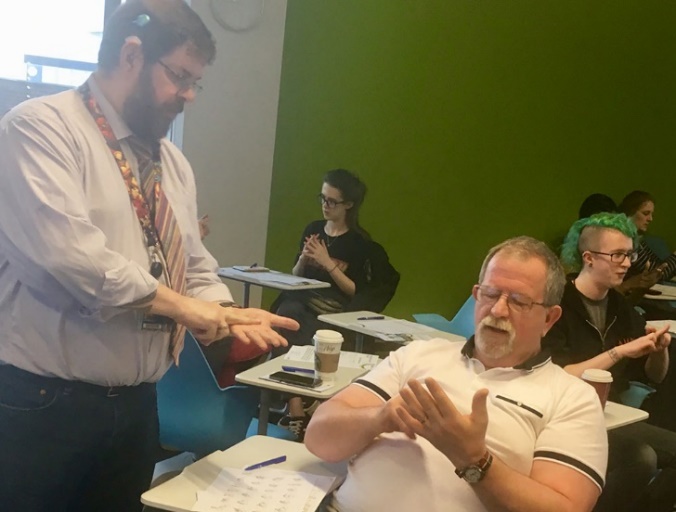
British Sign Language Taster Session with David Wolfe Rose

Leader and Cabinet Members' Young Person Grant Scheme Presentation evening, University Centre Telford

Knitting group’s special blankets for Dementia Ward
https://www.facebook.com/pg/UCTelfordWLV/photos/?ref=page_internal
Working from the Community end of the spectrum, we worked collaboratively sharing expertise/skills to connect the arts with health/wellbeing to reduce stigma and grow understanding. For example, the NHS Organ Donor Register was established in 1994 in Wolverhampton and in 2016 the Hospitals Trust approached us to run a student design competition to create a piece of public art for the entrance to New Cross Hospital A&E. The Gift of Life Sculpture project was the outcome of joint working between clinicians/nursing teams, recipient/donor families and School of Art.
The design was chosen by them. https://www.royalwolverhampton.nhs.uk/media/press-release-archive/press-releases-2016/the-royal-wolverhampton-nhs-trust-unveils-a-memorial-in-recogni/
This work has triggered other community-initiated P&CE including:
the Forget-Me-Not Window at the Telford Hospital Intensive Care Unit, a commemorative piece to recognise their donor/recipient journeys, initiated by them with students working with the clinical team and families;
https://www.youtube.com/watch?v=Y7Hp7PfmCZY&list=UU85gWFvuieBEvOjI4GfWcsQ&index=22
Living in Silence, an arts-based project to raise awareness of Inflammatory Bowel Disease in SE Asian women in the UK which is shrouded in stigma, https://youtu.be/ZJrCHdoml4c . This was praised by Crohns and Colitis UK and covered by BBC News and BBC Asian Network.
SignMedia projects focused on the needs of deaf/hard-of-hearing professionals to boost their media/other relevant employability skills by removing barriers to language through online apps that provide instant access to sign language, technical information and online training programmes.
www.signmediasmart.com https://signmediaenterprise.com/ http://www.signmediasmart.com/smvt-course/

The Gift of Life Sculpture project
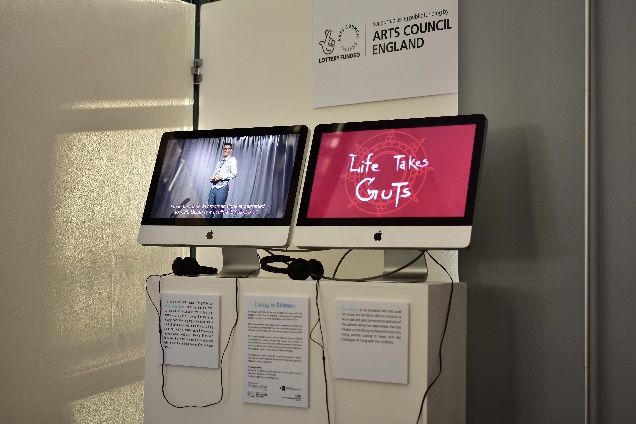
Sign Media outputs

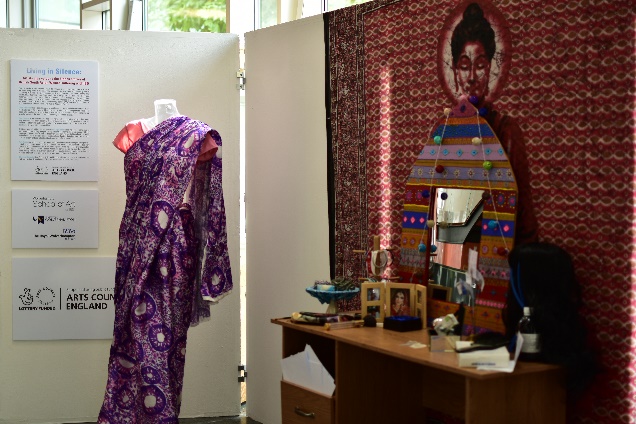
Living in Silence release and outputs
Working at the centre of the spectrum, WCLR is an example of co-production where a multi-agency partnership has come together to put learning at the heart of economic and social development of Wolverhampton, addressing 3 challenges: realising aspirations, higher skills, Mental H&W of adults. Part of UNESCO’s Global Network of Learning Cities, it brings international perspectives plus positions the city globally. In 2019, it coordinated the first Learning Festival.

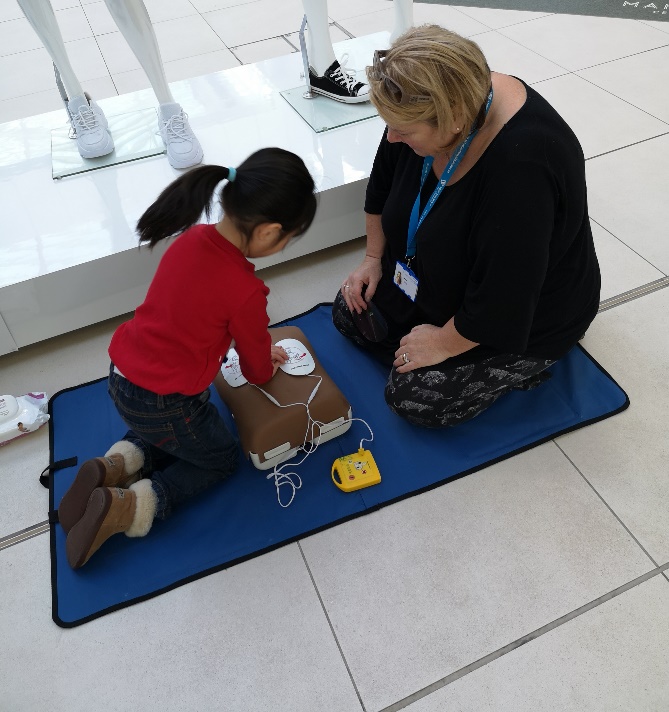
Wolverhampton City Learning Region (WCLR) Learning Festival
Aspect 4: Results and learning
Impacts of our role in creating social and economic transformation (employment/investment/ upskilling/CPD/higher skills) will not be evident for many years and are tracked by partners e.g. CWC, T&WC. These will be severely curtailed by the pandemic.
Using Telford, partnership-working to strengthen KE through increased understanding/capability and innovation has resulted in: £5m Marches Centre of Excellence in Allied Health increasing the exchange of university-generated knowledge and innovation in this field and working with communities and businesses; increased local HE offer (professional courses, CPD, activity/uptake); and transforming understanding of the value of knowledge and its role in employment and economic growth. University Centre Telford’s success resulted in two new successful centres, UoW in Stafford Centre and Black Country Studies Centre (collaboration with the BC Living Museum focused on heritage and the area’s future) and Towns Deal partnership bids for others.
Our model focuses on outcomes/impacts for communities/partners and us. Integrated multi-faceted P&CE work is evaluated and reported using key metrics as required by HE-BCIS. These do not capture complex transformational roles of P&CE for anchor universities with a civic mission e.g. positive changes in understanding engineering as a career for women.
Unlike Telford, STEM impacts are different and long-term focusing on increasing capability in our places. Impressive results are reflected in growth e.g. 10% increase in STEM subjects available, 38% in STEM graduates, increased progress across levels/modes of study, excellent ROI, new investment support e.g. new STEM/allied health provision in new locations in state-of-the-art premises. For partners it is engendering passion/new ways of engaging with adults/young people. We are tracking the range/type of impacts achieved.
Whilst resolving the challenges will require continued activity, excellent direct/indirect outcomes are achieved e.g. a major coup for Wolverhampton and recognition of its contribution to the arts, is securing the British Arts Show 9 in 2020 by the CWC and UoW.
Aspect 5: Acting on results
Our response in mobilising resources to support communities since March demonstrates both that our approach is excellent and our ability to act rapidly through ongoing P&CE. Activities include provision of equipment, repurposing labs/engineering facilities to produce PPE for H&SC providers and initiatives e.g. art packs/acoustic guitars for disadvantaged students, proactive engagement, and learning activities with/for all communities. During the pandemic, our online STEM activity achieved a global social media reach of 508,896 including 31,420 interactions across all social media platforms. The challenges of our place have been exacerbated by COVID-19, driving us to respond accordingly.
The Business Engagement & KEF Sub-Committee will consolidate existing P&CE reporting activity, create coordinated processes for linking outputs and outcomes; and ensure consistent evidence-gathering, models of investment, and evaluation measures using logic chains frameworks to ensure transparency, integration and consistency. Similarly, to celebrate the breadth and depth of our P&CE, a report will be shared with our public and communities as part of Vision 2030’s commitment to place.
For further information, please send queries to mary.mahoney@wlv.ac.uk
The term ‘city region’ to acknowledge that the initiative is not about a local authority area but where people work and/or live.↩︎
including sponsored schools (12 academies with 676 staff and 4792 students) https://www.uwmat.co.uk/↩︎
The group included people of all ages (see photograph above) including a nursing home resident who had never met online using Zoom.↩︎